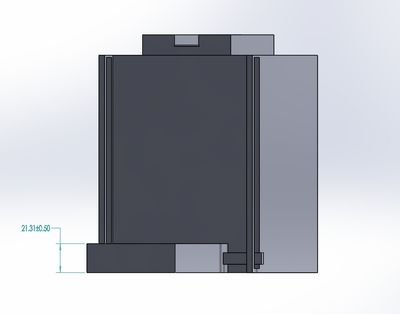BME100 f2017:Group5 W1030 L6
| Home People Lab Write-Up 1 | Lab Write-Up 2 | Lab Write-Up 3 Lab Write-Up 4 | Lab Write-Up 5 | Lab Write-Up 6 Course Logistics For Instructors Photos Wiki Editing Help | |||||
|
OUR COMPANY
SYBR LAB 6 WRITE-UPBayesian StatisticsOverview of the Original Diagnosis System For this lab, there were 16 groups with varying amount of students. Each team was given two patients with three sets of DNA per patient. Teams were also provided a positive and negative control to let them diagnose the patient. Several measures were taken by each team to prevent error. By providing three sets of DNA per patient, it let teams increase their sample size to lower the chance of error. Each team also was provided with a Positive and Negative control. This allowed teams to compare their data that they found from each patient with the Positive and Negative control in order to determine if the patient had the disease-associated SNP. Using the fluorimeter, three drop image photographs were taken of each set of DNA mixed with SYBR Green. By using three photographs, it reduced our chance of error by letting us calculate a mean value and standard deviation for the RAWINTDEN DROP - BACKGROUND value provided by ImageJ. ImageJ controls were also photographed. 6 varying amounts of DNA were photographed with SYBR Green to act as the control group. This allowed groups to compare their ImageJ values for their patient's DNA to the control group values. Of the 96 PCR reactions, 56 reactions had positive results while 39 reactions had negative results. Of the 32 conclusions, 17 had positive conclusions, 13 had negative conclusions, and 2 had inconclusive conclusions. A challenge that our group encountered was making sure that the camera stand did not move in between trials. If the camera stand did move between trails, the circle used for imageJ may not perfectly fit in drop from trial to trial. What Bayes Statistics Imply about This Diagnostic Approach According to calculation 1, the probability that a patient will receive a positive final test conclusion given a positive PCR reaction is about 80%. This value is fairly close to 100% and reveals that the PCR reaction results are generally accurate in determining if a patient has a disease SNP or not. The system has about an 80% sensitivity in its positive SNP disease detection ability. According to calculation 2, the probability that a patient will receive a negative test conclusion given a negative PCR reaction is about 100%. This value shows that a negative PCR reaction result is extremely accurate in determining whether or not a patient has a disease SNP. The system has almost a 100% specificity of its ability to detect that a patient does not have the disease SNP. According to calculation 3, there is only about a 50% probability that the patient will develop the disease based on a positive test conclusion. This means that the sensitivity of the system in predicting the disease is about 50%, which is not a very accurate value. According to calculation 4, there is about a 100% probability that the patient will not develop the disease based on a negative test conclusion. This indicates that the specificity of the reaction in predicting the patient does not have the disease is 100%. A possible error in the procedure that could have affected the Bayes value in a negative way is that when taking the pictures of the PCR with the gel is that the picture could have been unclear or from a bad angle. Another possible error is that the pipettor was put to a different volume and there could have been an excess of DNA or a shortage. Another possible reason that the Bayes value could be affected in a negative way is that the machine in which the tubes were put into had an error in the temperature and that it was not as cold or as hot as it was supposed to be. Intro to Computer-Aided Design3D Modeling The software used in this experiment was SolidWorks, which was very useful in allowing our team to modify the existing design of the fluorimeter. Our design modification includes a part that is adjustable in order to be very user-friendly. This was difficult to represent with SolidWorks, but the overall design was fairly easy to construct with this application. Since our design only modified one part, SolidWorks was the best option and allowed us to create an accurate visual representation of the new part. Overall the experience with this software was challenging, but it allowed us to most effectively render an accurate model of our product.
Our design differs from the original fluorimeter design because it allows the phone holder to be adjusted and can change based on phone size to allow for the better picture of the PCR to be taken. The phone holder is also attached to the fluorometer so that taking the picture would be easier and there is little room for error. The attachment allows for the phone stand to be adjusted from left to right, as well as up and down to accommodate for any type of phone camera. The original fluorimeter has the phone holder and the fluorometer in different parts making it difficult to adjust based on phone size. We chose this design because during the PCR lab this was the most difficult part to set-up and caused more room for error in photographing the reaction.
Feature 1: ConsumablesA very important consumable is a consumable that must be included in the packaging of the product as the product is useless without that part and is necessary for the person using the product to have. Some of the most crucial consumables in our product are the glass slides and the SYBR Green solution because these are the non machine items included in the packaging of the fluorometer and they are essential to the product. The target audience is scientists and college students so they will already have the PCR mix and the DNA samples.
Feature 2: Hardware - PCR Machine & FluorimeterThe PCR machine is not being modified because the original design is already fairly inexpensive and accurate for the PCR reactions. Our system is changing the fluorimeter instead, focusing on making the fluorimeter more accurate in photographing and being more user friendly. Both the Open PCR machine and the fluorimeter will still be used in the system, as it is the most cost effective and accurate process based on our group's evaluation. The new hardware our system will utilize is an adjustable phone stand that connects the fluorimeter, allowing for more clear images to be taken of the PCR reaction and therefore improving the accuracy of the results. Our group has decided to redesign the Fluorimeter based on the weaknesses that the Fluorimeter is difficult to set-up, and is not consistent in the distance and angle from which the photos are being taken. Our design addresses these issues, as the product ensures a precise way for the user to set up the phone camera without the stand or fluorimeter unintentionally being moved from one another. The phone stand will be connected at a fixed distance away from the fluorimeter (4 cm), but has the ability to be manually adjusted vertically and horizontally by the user. This minimizes error and allows the user to consistently capture images from the same distance each time a new sample placed in the fluorimeter.
| |||||


